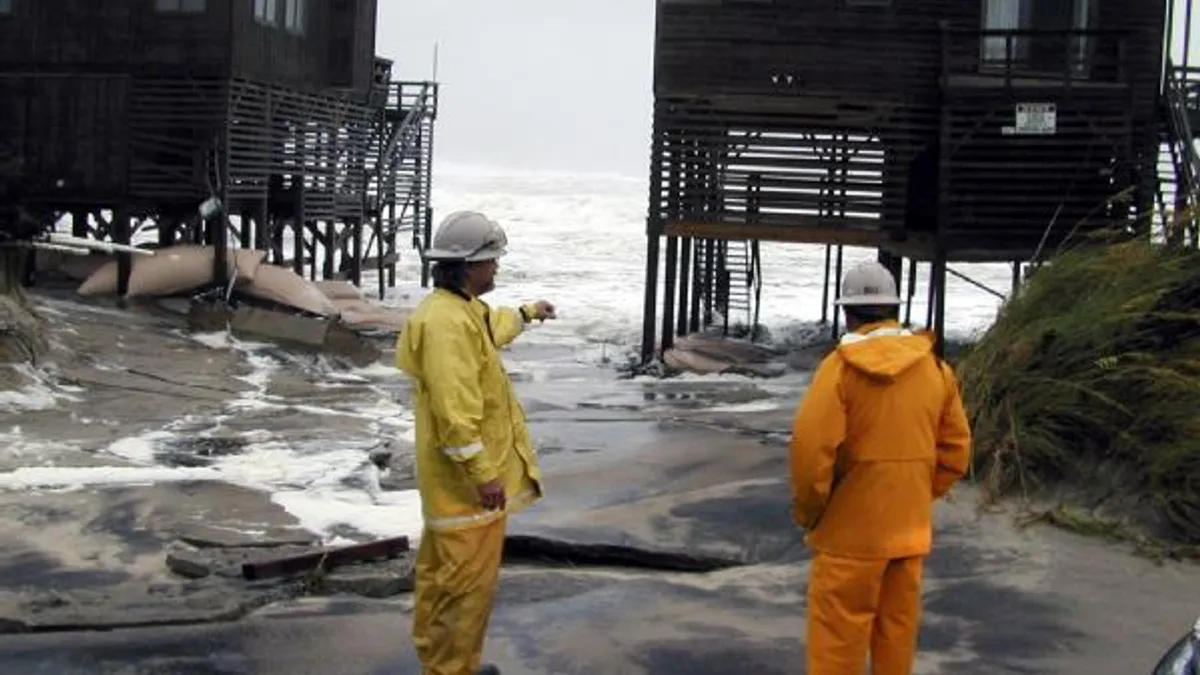Dive Brief:
- Sea level rise in the contiguous United States is expected to make tidal flooding worse, which puts 311,000 homes worth about $117.5 billion at risk of chronic flooding over the next 30 years, according to a study from the Union of Concerned Scientists (UCS). The number of at-risk homes is projected to climb to 2.4 million, worth $912 billion, by the end of the century.
- States most at risk of being affected by the end of the century are Florida, with 1 million homes; New Jersey, with 250,000 homes; and New York, with 143,000 homes. In addition to chronically flooded areas becoming unlivable, the most at-risk communities could lose billions in tax revenue that funds services such as schools, roads and emergency services.
- The cost of sea level rise is expected to disproportionately affect low-income and rural areas. The report identified 75 communities where about 30% of the property tax base is at risk, and about one-third of those have poverty rates higher than the national average. The hardest hit communities by this metric will be in Louisiana, Maryland, New Jersey and North Carolina.
Dive Insight:
The UCS study is based on an analysis of data made available by real estate company Zillow. The researchers considered "chronic flooding" to be areas that are flooded 26 times per year or more in the next several decades, even without major storms. It includes interactive maps that show flood risks nationally, by state, by city and by ZIP code.
This study is significant because of the large number of Americans living in what are considered coastal areas; populations in coastal communities are denser than in other parts of the country and continue to increase. The National Oceanic and Atmospheric Administration estimates that 40% of Americans lived along the shore in 2010, and that number is expected to increase 8% by 2020.
This study does not bode well for communities that are already experiencing the effects of sea level rise. South Florida, which is an area of particular concern in the UCS study, is a prime example. Sea level rise in cities like Miami has become so well known that leaders and organizations are actively looking for ways to mitigate the problem. For example, this spring the Knight Foundation granted the Harvard University Graduate School of Design $1 million for a three-year study to come up with solutions to Miami's and Miami Beach's most pressing sustainability and resiliency challenges, including climate change.
South Florida's situation also highlights the inequity often evident in flood plain management. As some wealthy Miami Beach residents fear losing their homes to flooding on the coastal island, they're apparently looking to move onto the mainland, into Miami. But the higher-ground areas they're reportedly eyeing for relocation are low-income neighborhoods that could be razed and redeveloped to accommodate high-income housing. Plus, the UCS study points out that low-income neighborhoods have fewer resources to prevent or recover from chronic flooding.
Relocating to mainland Miami isn't necessarily a long-term answer for escaping devastating floods, either. Like Ft. Lauderdale and most other parts of South Florida, in recent years Miami has been affected by king tides, which cause ocean water to flood streets during certain tidal pulls, even if it hasn't rained. Researchers expect more coastal communities throughout the country to experience this kind of flooding in the coming years if conditions remain the same.
UCS did not simply offer a doom and gloom report without hope for reversing the negative findings. It says that taking action now — especially reducing carbon emissions — will affect climate change and coastal conditions in the coming years. Just as humans are considered a leading cause of climate change, they can also be a solution to mitigate the effects and create more resilient cities.
“If we manage to meet the goals of the Paris Agreement by keeping warming to between 1.5 and 2 degrees Celsius and if ice loss is limited, 85% of all affected residential properties... could avoid chronic flooding this century. The longer we wait to drastically reduce emissions, the less likely it is that we will achieve this outcome,” said Astrid Caldas, senior climate scientist at UCS and report co-author, in a statement.
UCS suggests that the easiest and most impactful action for cities to take is changing policies that either exacerbate or do not work to combat the growing flood risk impact on homes. Inaccurate flood risk information, subsidized insurance, zoning codes, building codes and incentives are issues on which cities can improve. Cities can, for example, reexamine and update their flood plain map and then implement zoning changes to prevent or limit further residential development in flood-prone areas.












